Company Law Report: Prest v. Petrodel Resources & Combat Ltd Analysis
VerifiedAdded on 2023/01/16
|18
|5324
|59
Report
AI Summary
This report provides a comprehensive analysis of two key scenarios in company law: Prest v. Petrodel Resources Ltd and the case of Combat Ltd. The first part summarizes the facts of Prest v. Petrodel, a landmark case concerning the piercing of the corporate veil, and critically evaluates the Supreme Court's contribution to the understanding of this doctrine. The analysis delves into the circumstances under which the corporate veil is avoided, examining the decisions of the Family Court, Court of Appeal, and Supreme Court. The second part addresses a case study involving Combat Ltd, a paintballing company. The report assesses various issues, including directors' duties, shareholder rights, potential breaches of duty, and remedies available to shareholders. The analysis explores the responsibilities of Peter and Bernard, the majority shareholders and directors, and the rights of the minority shareholders. The report offers a detailed examination of the legal principles applicable to each scenario, drawing upon relevant case law and statutory provisions to provide a thorough understanding of company law principles.
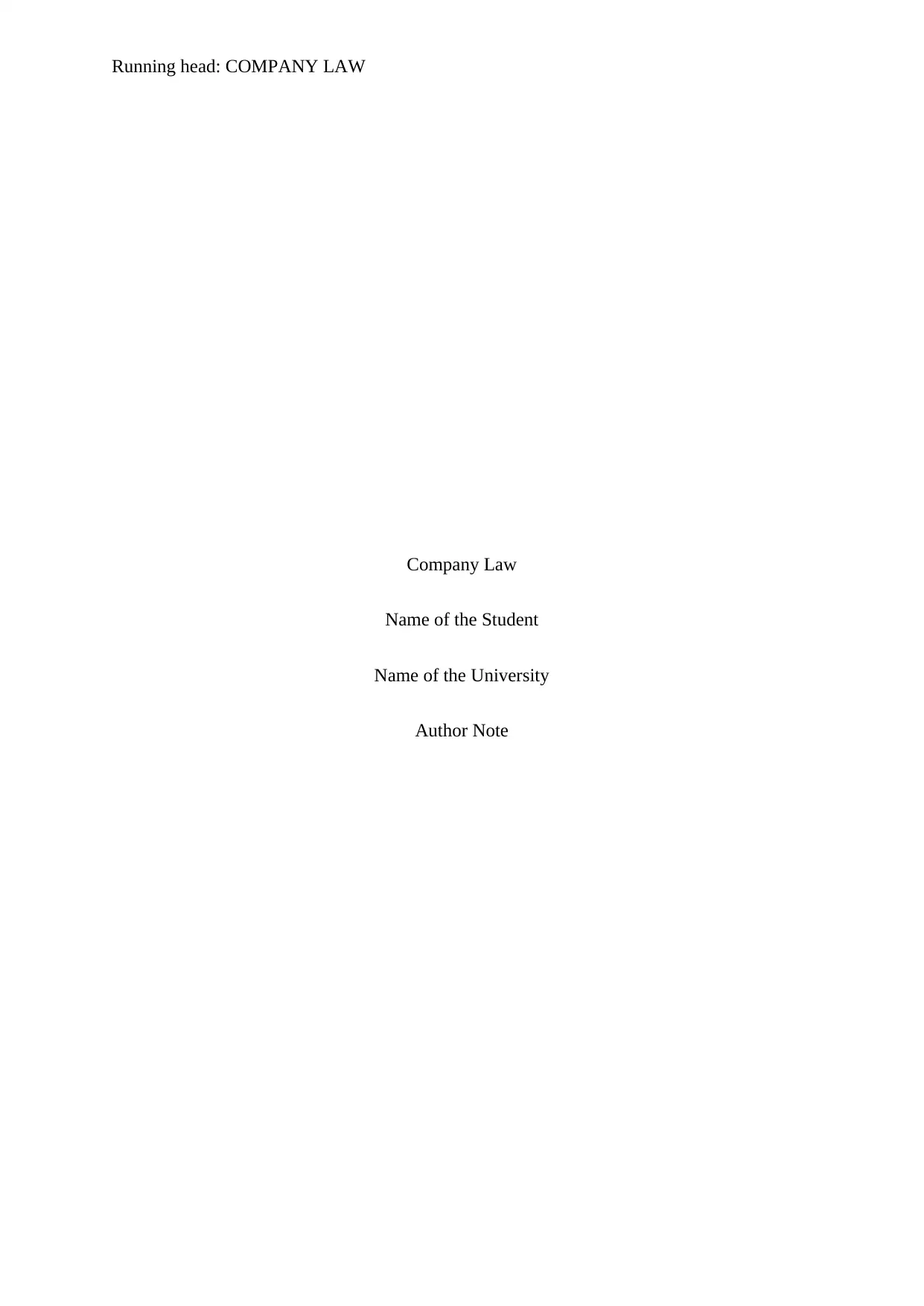
Running head: COMPANY LAW
Company Law
Name of the Student
Name of the University
Author Note
Company Law
Name of the Student
Name of the University
Author Note
Paraphrase This Document
Need a fresh take? Get an instant paraphrase of this document with our AI Paraphraser

1COMPANY LAW
Table of Contents
Question 1..................................................................................................................................2
Introduction............................................................................................................................2
Facts of the case.....................................................................................................................2
Critical Evaluation of the decisions of various Courts...........................................................3
Decision of the Family Court.............................................................................................4
Decision of the Court of Appeal........................................................................................5
Decision of the Supreme Court..........................................................................................5
Conclusion..............................................................................................................................8
Question 2..................................................................................................................................9
Issue 1.....................................................................................................................................9
Issue 2...................................................................................................................................10
Issue 3...................................................................................................................................11
Issue 4...................................................................................................................................13
Reference..................................................................................................................................16
Table of Contents
Question 1..................................................................................................................................2
Introduction............................................................................................................................2
Facts of the case.....................................................................................................................2
Critical Evaluation of the decisions of various Courts...........................................................3
Decision of the Family Court.............................................................................................4
Decision of the Court of Appeal........................................................................................5
Decision of the Supreme Court..........................................................................................5
Conclusion..............................................................................................................................8
Question 2..................................................................................................................................9
Issue 1.....................................................................................................................................9
Issue 2...................................................................................................................................10
Issue 3...................................................................................................................................11
Issue 4...................................................................................................................................13
Reference..................................................................................................................................16
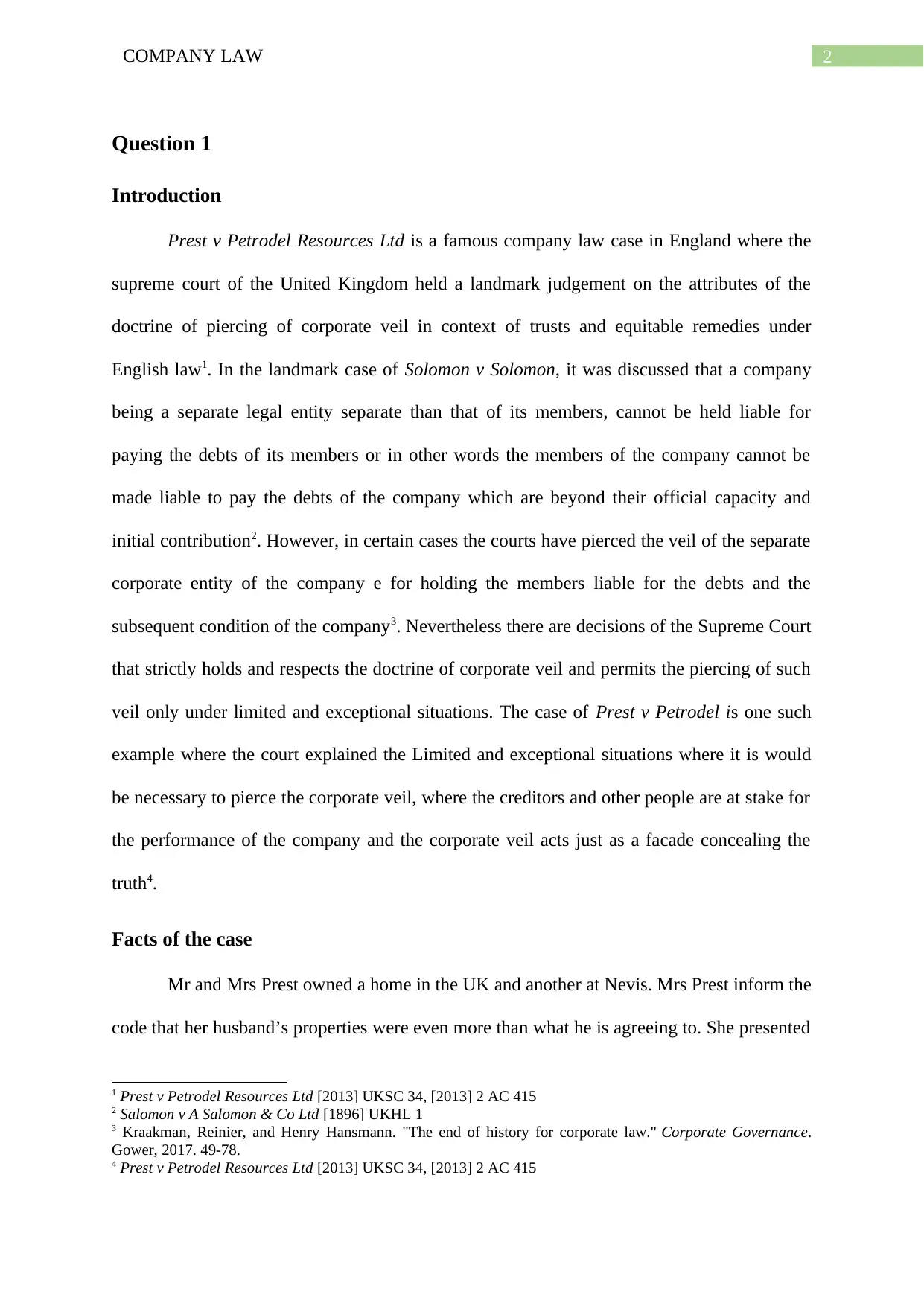
2COMPANY LAW
Question 1
Introduction
Prest v Petrodel Resources Ltd is a famous company law case in England where the
supreme court of the United Kingdom held a landmark judgement on the attributes of the
doctrine of piercing of corporate veil in context of trusts and equitable remedies under
English law1. In the landmark case of Solomon v Solomon, it was discussed that a company
being a separate legal entity separate than that of its members, cannot be held liable for
paying the debts of its members or in other words the members of the company cannot be
made liable to pay the debts of the company which are beyond their official capacity and
initial contribution2. However, in certain cases the courts have pierced the veil of the separate
corporate entity of the company e for holding the members liable for the debts and the
subsequent condition of the company3. Nevertheless there are decisions of the Supreme Court
that strictly holds and respects the doctrine of corporate veil and permits the piercing of such
veil only under limited and exceptional situations. The case of Prest v Petrodel is one such
example where the court explained the Limited and exceptional situations where it is would
be necessary to pierce the corporate veil, where the creditors and other people are at stake for
the performance of the company and the corporate veil acts just as a facade concealing the
truth4.
Facts of the case
Mr and Mrs Prest owned a home in the UK and another at Nevis. Mrs Prest inform the
code that her husband’s properties were even more than what he is agreeing to. She presented
1 Prest v Petrodel Resources Ltd [2013] UKSC 34, [2013] 2 AC 415
2 Salomon v A Salomon & Co Ltd [1896] UKHL 1
3 Kraakman, Reinier, and Henry Hansmann. "The end of history for corporate law." Corporate Governance.
Gower, 2017. 49-78.
4 Prest v Petrodel Resources Ltd [2013] UKSC 34, [2013] 2 AC 415
Question 1
Introduction
Prest v Petrodel Resources Ltd is a famous company law case in England where the
supreme court of the United Kingdom held a landmark judgement on the attributes of the
doctrine of piercing of corporate veil in context of trusts and equitable remedies under
English law1. In the landmark case of Solomon v Solomon, it was discussed that a company
being a separate legal entity separate than that of its members, cannot be held liable for
paying the debts of its members or in other words the members of the company cannot be
made liable to pay the debts of the company which are beyond their official capacity and
initial contribution2. However, in certain cases the courts have pierced the veil of the separate
corporate entity of the company e for holding the members liable for the debts and the
subsequent condition of the company3. Nevertheless there are decisions of the Supreme Court
that strictly holds and respects the doctrine of corporate veil and permits the piercing of such
veil only under limited and exceptional situations. The case of Prest v Petrodel is one such
example where the court explained the Limited and exceptional situations where it is would
be necessary to pierce the corporate veil, where the creditors and other people are at stake for
the performance of the company and the corporate veil acts just as a facade concealing the
truth4.
Facts of the case
Mr and Mrs Prest owned a home in the UK and another at Nevis. Mrs Prest inform the
code that her husband’s properties were even more than what he is agreeing to. She presented
1 Prest v Petrodel Resources Ltd [2013] UKSC 34, [2013] 2 AC 415
2 Salomon v A Salomon & Co Ltd [1896] UKHL 1
3 Kraakman, Reinier, and Henry Hansmann. "The end of history for corporate law." Corporate Governance.
Gower, 2017. 49-78.
4 Prest v Petrodel Resources Ltd [2013] UKSC 34, [2013] 2 AC 415
⊘ This is a preview!⊘
Do you want full access?
Subscribe today to unlock all pages.

Trusted by 1+ million students worldwide
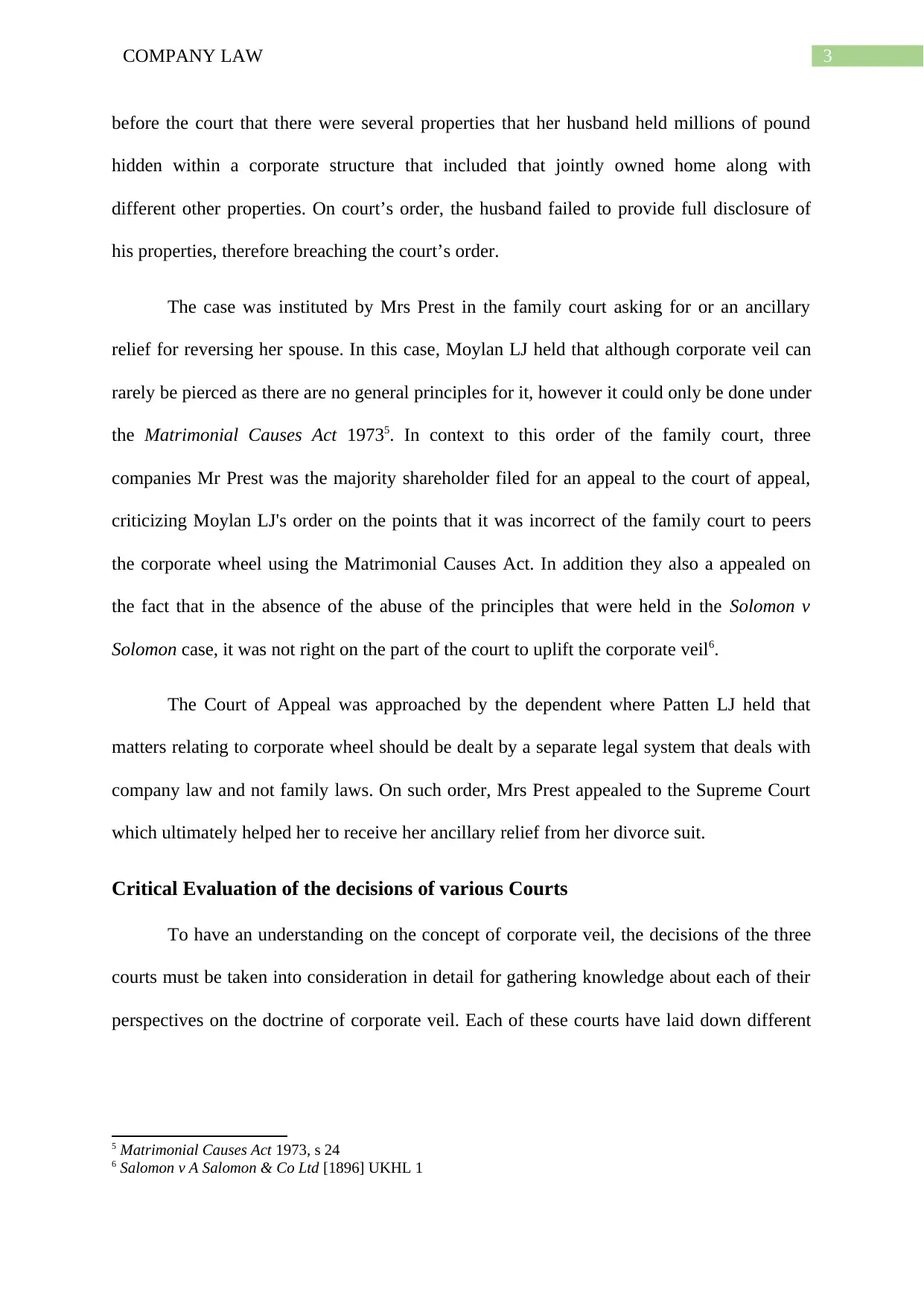
3COMPANY LAW
before the court that there were several properties that her husband held millions of pound
hidden within a corporate structure that included that jointly owned home along with
different other properties. On court’s order, the husband failed to provide full disclosure of
his properties, therefore breaching the court’s order.
The case was instituted by Mrs Prest in the family court asking for or an ancillary
relief for reversing her spouse. In this case, Moylan LJ held that although corporate veil can
rarely be pierced as there are no general principles for it, however it could only be done under
the Matrimonial Causes Act 19735. In context to this order of the family court, three
companies Mr Prest was the majority shareholder filed for an appeal to the court of appeal,
criticizing Moylan LJ's order on the points that it was incorrect of the family court to peers
the corporate wheel using the Matrimonial Causes Act. In addition they also a appealed on
the fact that in the absence of the abuse of the principles that were held in the Solomon v
Solomon case, it was not right on the part of the court to uplift the corporate veil6.
The Court of Appeal was approached by the dependent where Patten LJ held that
matters relating to corporate wheel should be dealt by a separate legal system that deals with
company law and not family laws. On such order, Mrs Prest appealed to the Supreme Court
which ultimately helped her to receive her ancillary relief from her divorce suit.
Critical Evaluation of the decisions of various Courts
To have an understanding on the concept of corporate veil, the decisions of the three
courts must be taken into consideration in detail for gathering knowledge about each of their
perspectives on the doctrine of corporate veil. Each of these courts have laid down different
5 Matrimonial Causes Act 1973, s 24
6 Salomon v A Salomon & Co Ltd [1896] UKHL 1
before the court that there were several properties that her husband held millions of pound
hidden within a corporate structure that included that jointly owned home along with
different other properties. On court’s order, the husband failed to provide full disclosure of
his properties, therefore breaching the court’s order.
The case was instituted by Mrs Prest in the family court asking for or an ancillary
relief for reversing her spouse. In this case, Moylan LJ held that although corporate veil can
rarely be pierced as there are no general principles for it, however it could only be done under
the Matrimonial Causes Act 19735. In context to this order of the family court, three
companies Mr Prest was the majority shareholder filed for an appeal to the court of appeal,
criticizing Moylan LJ's order on the points that it was incorrect of the family court to peers
the corporate wheel using the Matrimonial Causes Act. In addition they also a appealed on
the fact that in the absence of the abuse of the principles that were held in the Solomon v
Solomon case, it was not right on the part of the court to uplift the corporate veil6.
The Court of Appeal was approached by the dependent where Patten LJ held that
matters relating to corporate wheel should be dealt by a separate legal system that deals with
company law and not family laws. On such order, Mrs Prest appealed to the Supreme Court
which ultimately helped her to receive her ancillary relief from her divorce suit.
Critical Evaluation of the decisions of various Courts
To have an understanding on the concept of corporate veil, the decisions of the three
courts must be taken into consideration in detail for gathering knowledge about each of their
perspectives on the doctrine of corporate veil. Each of these courts have laid down different
5 Matrimonial Causes Act 1973, s 24
6 Salomon v A Salomon & Co Ltd [1896] UKHL 1
Paraphrase This Document
Need a fresh take? Get an instant paraphrase of this document with our AI Paraphraser
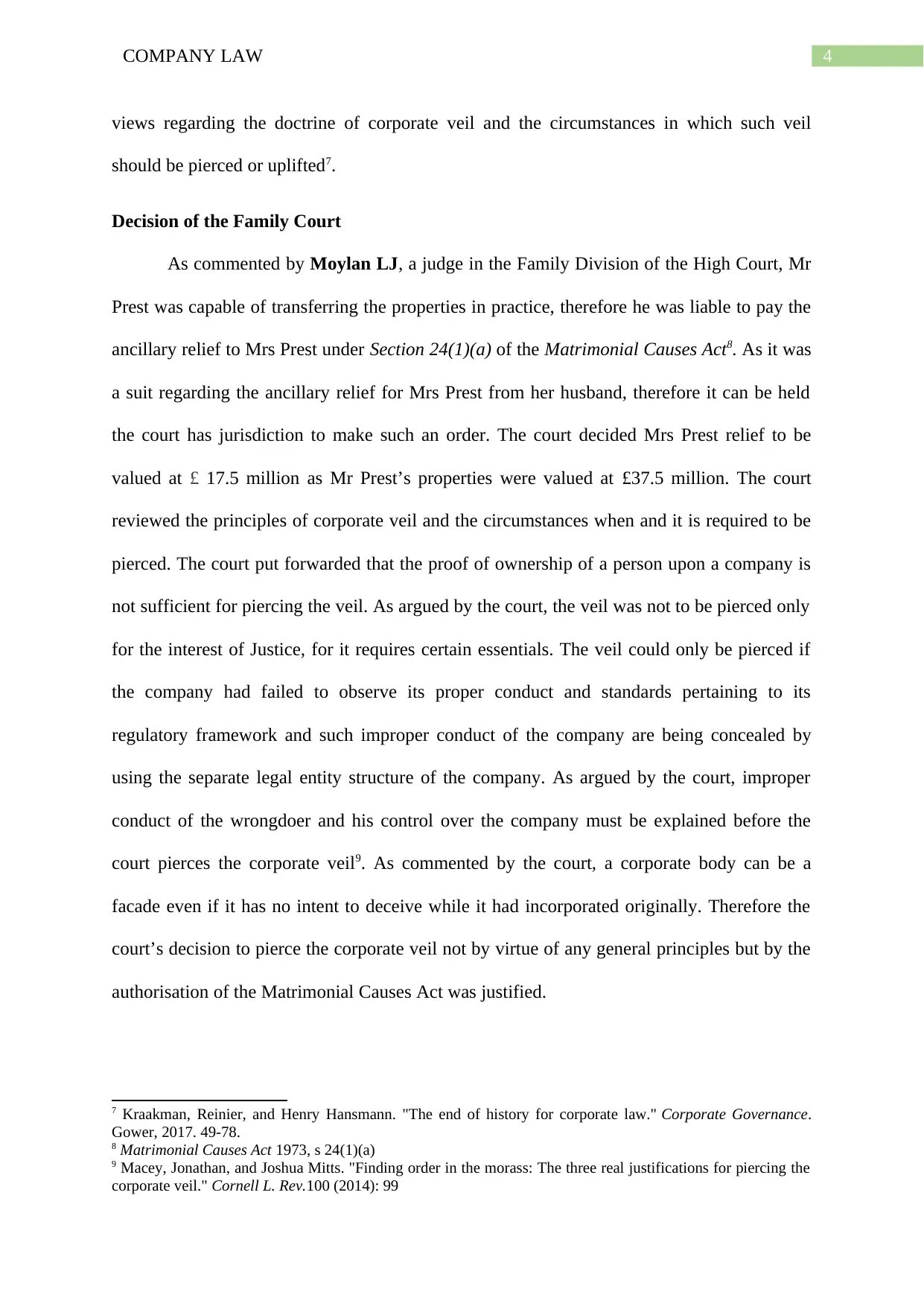
4COMPANY LAW
views regarding the doctrine of corporate veil and the circumstances in which such veil
should be pierced or uplifted7.
Decision of the Family Court
As commented by Moylan LJ, a judge in the Family Division of the High Court, Mr
Prest was capable of transferring the properties in practice, therefore he was liable to pay the
ancillary relief to Mrs Prest under Section 24(1)(a) of the Matrimonial Causes Act8. As it was
a suit regarding the ancillary relief for Mrs Prest from her husband, therefore it can be held
the court has jurisdiction to make such an order. The court decided Mrs Prest relief to be
valued at £ 17.5 million as Mr Prest’s properties were valued at £37.5 million. The court
reviewed the principles of corporate veil and the circumstances when and it is required to be
pierced. The court put forwarded that the proof of ownership of a person upon a company is
not sufficient for piercing the veil. As argued by the court, the veil was not to be pierced only
for the interest of Justice, for it requires certain essentials. The veil could only be pierced if
the company had failed to observe its proper conduct and standards pertaining to its
regulatory framework and such improper conduct of the company are being concealed by
using the separate legal entity structure of the company. As argued by the court, improper
conduct of the wrongdoer and his control over the company must be explained before the
court pierces the corporate veil9. As commented by the court, a corporate body can be a
facade even if it has no intent to deceive while it had incorporated originally. Therefore the
court’s decision to pierce the corporate veil not by virtue of any general principles but by the
authorisation of the Matrimonial Causes Act was justified.
7 Kraakman, Reinier, and Henry Hansmann. "The end of history for corporate law." Corporate Governance.
Gower, 2017. 49-78.
8 Matrimonial Causes Act 1973, s 24(1)(a)
9 Macey, Jonathan, and Joshua Mitts. "Finding order in the morass: The three real justifications for piercing the
corporate veil." Cornell L. Rev.100 (2014): 99
views regarding the doctrine of corporate veil and the circumstances in which such veil
should be pierced or uplifted7.
Decision of the Family Court
As commented by Moylan LJ, a judge in the Family Division of the High Court, Mr
Prest was capable of transferring the properties in practice, therefore he was liable to pay the
ancillary relief to Mrs Prest under Section 24(1)(a) of the Matrimonial Causes Act8. As it was
a suit regarding the ancillary relief for Mrs Prest from her husband, therefore it can be held
the court has jurisdiction to make such an order. The court decided Mrs Prest relief to be
valued at £ 17.5 million as Mr Prest’s properties were valued at £37.5 million. The court
reviewed the principles of corporate veil and the circumstances when and it is required to be
pierced. The court put forwarded that the proof of ownership of a person upon a company is
not sufficient for piercing the veil. As argued by the court, the veil was not to be pierced only
for the interest of Justice, for it requires certain essentials. The veil could only be pierced if
the company had failed to observe its proper conduct and standards pertaining to its
regulatory framework and such improper conduct of the company are being concealed by
using the separate legal entity structure of the company. As argued by the court, improper
conduct of the wrongdoer and his control over the company must be explained before the
court pierces the corporate veil9. As commented by the court, a corporate body can be a
facade even if it has no intent to deceive while it had incorporated originally. Therefore the
court’s decision to pierce the corporate veil not by virtue of any general principles but by the
authorisation of the Matrimonial Causes Act was justified.
7 Kraakman, Reinier, and Henry Hansmann. "The end of history for corporate law." Corporate Governance.
Gower, 2017. 49-78.
8 Matrimonial Causes Act 1973, s 24(1)(a)
9 Macey, Jonathan, and Joshua Mitts. "Finding order in the morass: The three real justifications for piercing the
corporate veil." Cornell L. Rev.100 (2014): 99
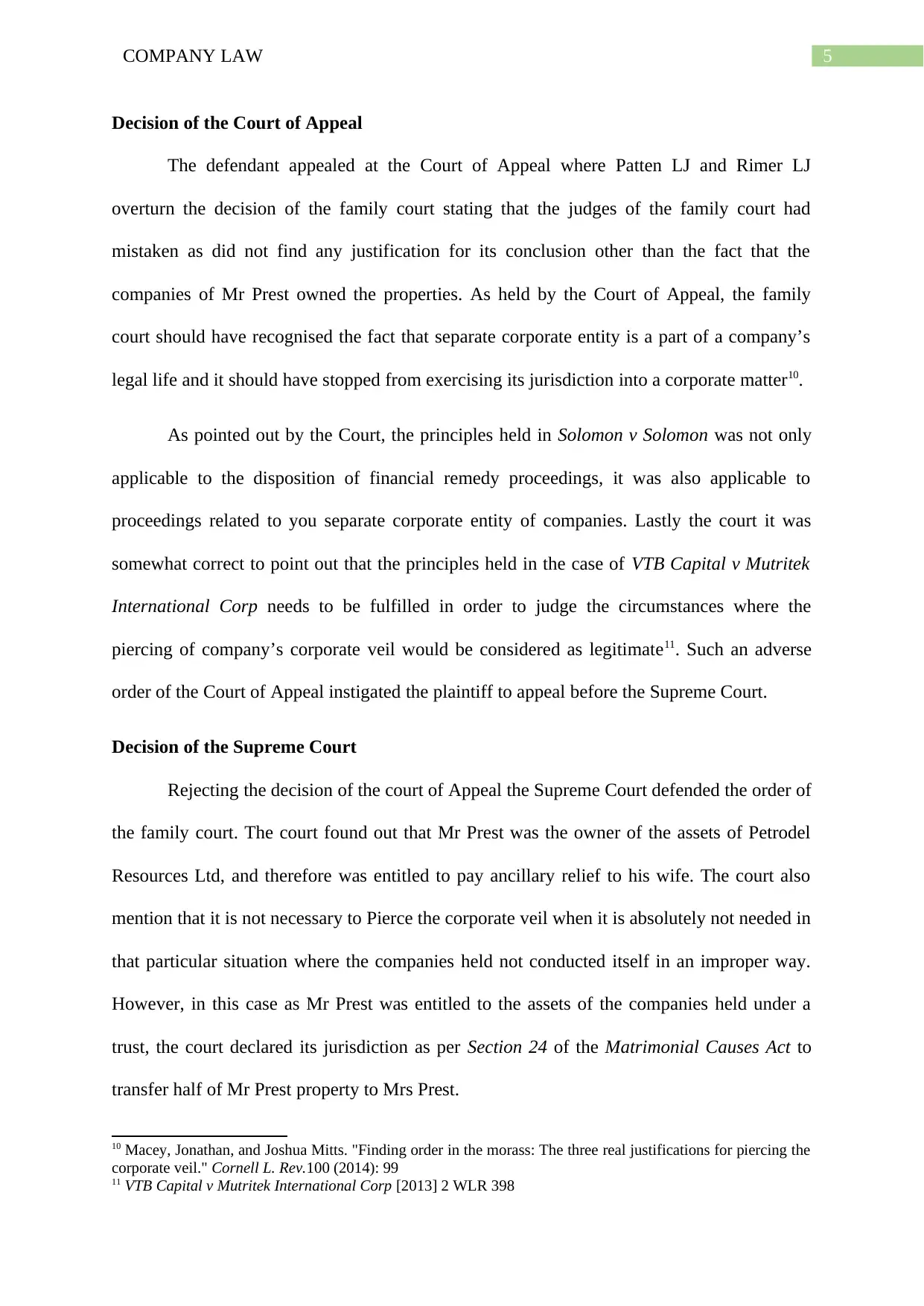
5COMPANY LAW
Decision of the Court of Appeal
The defendant appealed at the Court of Appeal where Patten LJ and Rimer LJ
overturn the decision of the family court stating that the judges of the family court had
mistaken as did not find any justification for its conclusion other than the fact that the
companies of Mr Prest owned the properties. As held by the Court of Appeal, the family
court should have recognised the fact that separate corporate entity is a part of a company’s
legal life and it should have stopped from exercising its jurisdiction into a corporate matter10.
As pointed out by the Court, the principles held in Solomon v Solomon was not only
applicable to the disposition of financial remedy proceedings, it was also applicable to
proceedings related to you separate corporate entity of companies. Lastly the court it was
somewhat correct to point out that the principles held in the case of VTB Capital v Mutritek
International Corp needs to be fulfilled in order to judge the circumstances where the
piercing of company’s corporate veil would be considered as legitimate11. Such an adverse
order of the Court of Appeal instigated the plaintiff to appeal before the Supreme Court.
Decision of the Supreme Court
Rejecting the decision of the court of Appeal the Supreme Court defended the order of
the family court. The court found out that Mr Prest was the owner of the assets of Petrodel
Resources Ltd, and therefore was entitled to pay ancillary relief to his wife. The court also
mention that it is not necessary to Pierce the corporate veil when it is absolutely not needed in
that particular situation where the companies held not conducted itself in an improper way.
However, in this case as Mr Prest was entitled to the assets of the companies held under a
trust, the court declared its jurisdiction as per Section 24 of the Matrimonial Causes Act to
transfer half of Mr Prest property to Mrs Prest.
10 Macey, Jonathan, and Joshua Mitts. "Finding order in the morass: The three real justifications for piercing the
corporate veil." Cornell L. Rev.100 (2014): 99
11 VTB Capital v Mutritek International Corp [2013] 2 WLR 398
Decision of the Court of Appeal
The defendant appealed at the Court of Appeal where Patten LJ and Rimer LJ
overturn the decision of the family court stating that the judges of the family court had
mistaken as did not find any justification for its conclusion other than the fact that the
companies of Mr Prest owned the properties. As held by the Court of Appeal, the family
court should have recognised the fact that separate corporate entity is a part of a company’s
legal life and it should have stopped from exercising its jurisdiction into a corporate matter10.
As pointed out by the Court, the principles held in Solomon v Solomon was not only
applicable to the disposition of financial remedy proceedings, it was also applicable to
proceedings related to you separate corporate entity of companies. Lastly the court it was
somewhat correct to point out that the principles held in the case of VTB Capital v Mutritek
International Corp needs to be fulfilled in order to judge the circumstances where the
piercing of company’s corporate veil would be considered as legitimate11. Such an adverse
order of the Court of Appeal instigated the plaintiff to appeal before the Supreme Court.
Decision of the Supreme Court
Rejecting the decision of the court of Appeal the Supreme Court defended the order of
the family court. The court found out that Mr Prest was the owner of the assets of Petrodel
Resources Ltd, and therefore was entitled to pay ancillary relief to his wife. The court also
mention that it is not necessary to Pierce the corporate veil when it is absolutely not needed in
that particular situation where the companies held not conducted itself in an improper way.
However, in this case as Mr Prest was entitled to the assets of the companies held under a
trust, the court declared its jurisdiction as per Section 24 of the Matrimonial Causes Act to
transfer half of Mr Prest property to Mrs Prest.
10 Macey, Jonathan, and Joshua Mitts. "Finding order in the morass: The three real justifications for piercing the
corporate veil." Cornell L. Rev.100 (2014): 99
11 VTB Capital v Mutritek International Corp [2013] 2 WLR 398
⊘ This is a preview!⊘
Do you want full access?
Subscribe today to unlock all pages.

Trusted by 1+ million students worldwide
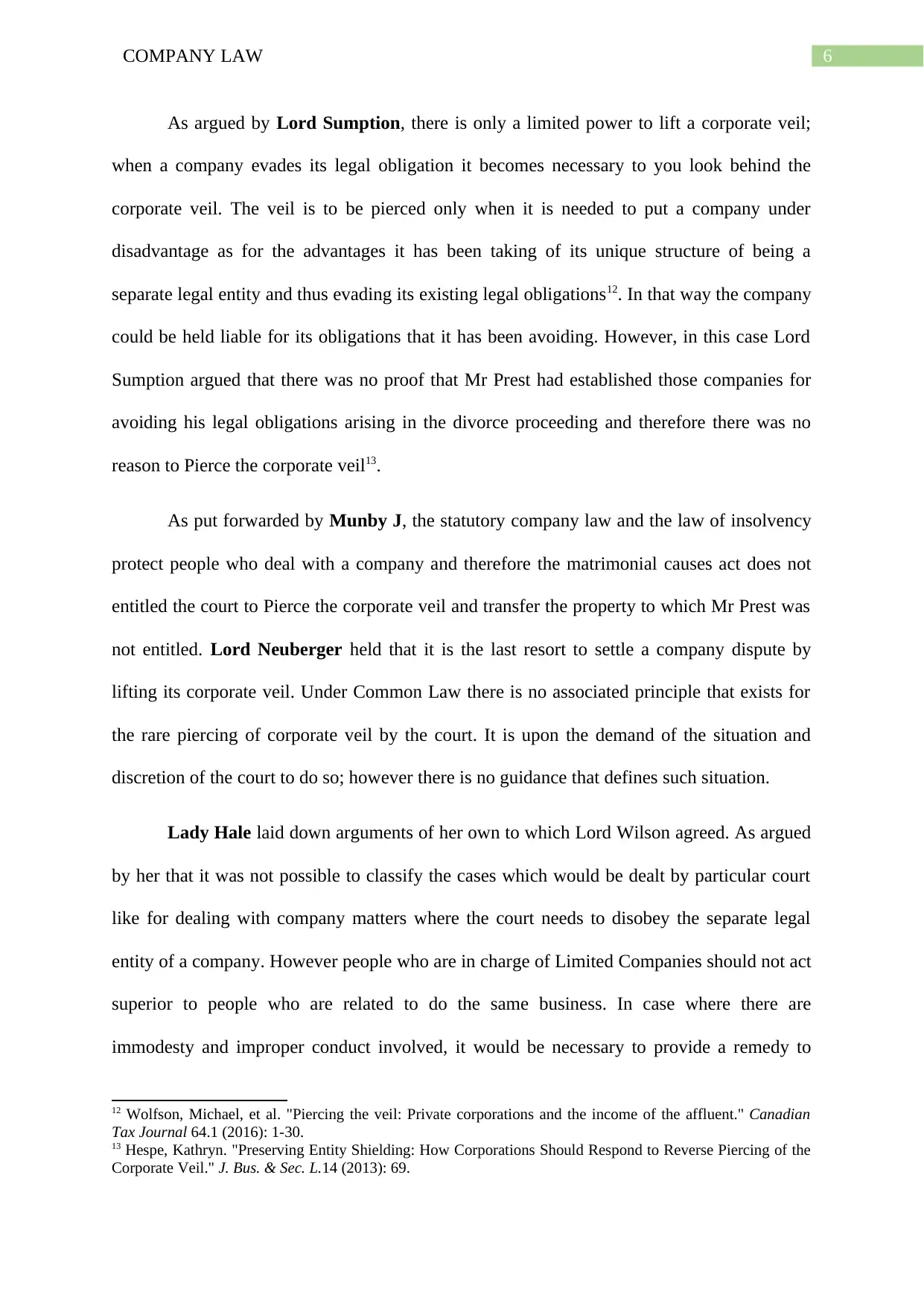
6COMPANY LAW
As argued by Lord Sumption, there is only a limited power to lift a corporate veil;
when a company evades its legal obligation it becomes necessary to you look behind the
corporate veil. The veil is to be pierced only when it is needed to put a company under
disadvantage as for the advantages it has been taking of its unique structure of being a
separate legal entity and thus evading its existing legal obligations12. In that way the company
could be held liable for its obligations that it has been avoiding. However, in this case Lord
Sumption argued that there was no proof that Mr Prest had established those companies for
avoiding his legal obligations arising in the divorce proceeding and therefore there was no
reason to Pierce the corporate veil13.
As put forwarded by Munby J, the statutory company law and the law of insolvency
protect people who deal with a company and therefore the matrimonial causes act does not
entitled the court to Pierce the corporate veil and transfer the property to which Mr Prest was
not entitled. Lord Neuberger held that it is the last resort to settle a company dispute by
lifting its corporate veil. Under Common Law there is no associated principle that exists for
the rare piercing of corporate veil by the court. It is upon the demand of the situation and
discretion of the court to do so; however there is no guidance that defines such situation.
Lady Hale laid down arguments of her own to which Lord Wilson agreed. As argued
by her that it was not possible to classify the cases which would be dealt by particular court
like for dealing with company matters where the court needs to disobey the separate legal
entity of a company. However people who are in charge of Limited Companies should not act
superior to people who are related to do the same business. In case where there are
immodesty and improper conduct involved, it would be necessary to provide a remedy to
12 Wolfson, Michael, et al. "Piercing the veil: Private corporations and the income of the affluent." Canadian
Tax Journal 64.1 (2016): 1-30.
13 Hespe, Kathryn. "Preserving Entity Shielding: How Corporations Should Respond to Reverse Piercing of the
Corporate Veil." J. Bus. & Sec. L.14 (2013): 69.
As argued by Lord Sumption, there is only a limited power to lift a corporate veil;
when a company evades its legal obligation it becomes necessary to you look behind the
corporate veil. The veil is to be pierced only when it is needed to put a company under
disadvantage as for the advantages it has been taking of its unique structure of being a
separate legal entity and thus evading its existing legal obligations12. In that way the company
could be held liable for its obligations that it has been avoiding. However, in this case Lord
Sumption argued that there was no proof that Mr Prest had established those companies for
avoiding his legal obligations arising in the divorce proceeding and therefore there was no
reason to Pierce the corporate veil13.
As put forwarded by Munby J, the statutory company law and the law of insolvency
protect people who deal with a company and therefore the matrimonial causes act does not
entitled the court to Pierce the corporate veil and transfer the property to which Mr Prest was
not entitled. Lord Neuberger held that it is the last resort to settle a company dispute by
lifting its corporate veil. Under Common Law there is no associated principle that exists for
the rare piercing of corporate veil by the court. It is upon the demand of the situation and
discretion of the court to do so; however there is no guidance that defines such situation.
Lady Hale laid down arguments of her own to which Lord Wilson agreed. As argued
by her that it was not possible to classify the cases which would be dealt by particular court
like for dealing with company matters where the court needs to disobey the separate legal
entity of a company. However people who are in charge of Limited Companies should not act
superior to people who are related to do the same business. In case where there are
immodesty and improper conduct involved, it would be necessary to provide a remedy to
12 Wolfson, Michael, et al. "Piercing the veil: Private corporations and the income of the affluent." Canadian
Tax Journal 64.1 (2016): 1-30.
13 Hespe, Kathryn. "Preserving Entity Shielding: How Corporations Should Respond to Reverse Piercing of the
Corporate Veil." J. Bus. & Sec. L.14 (2013): 69.
Paraphrase This Document
Need a fresh take? Get an instant paraphrase of this document with our AI Paraphraser
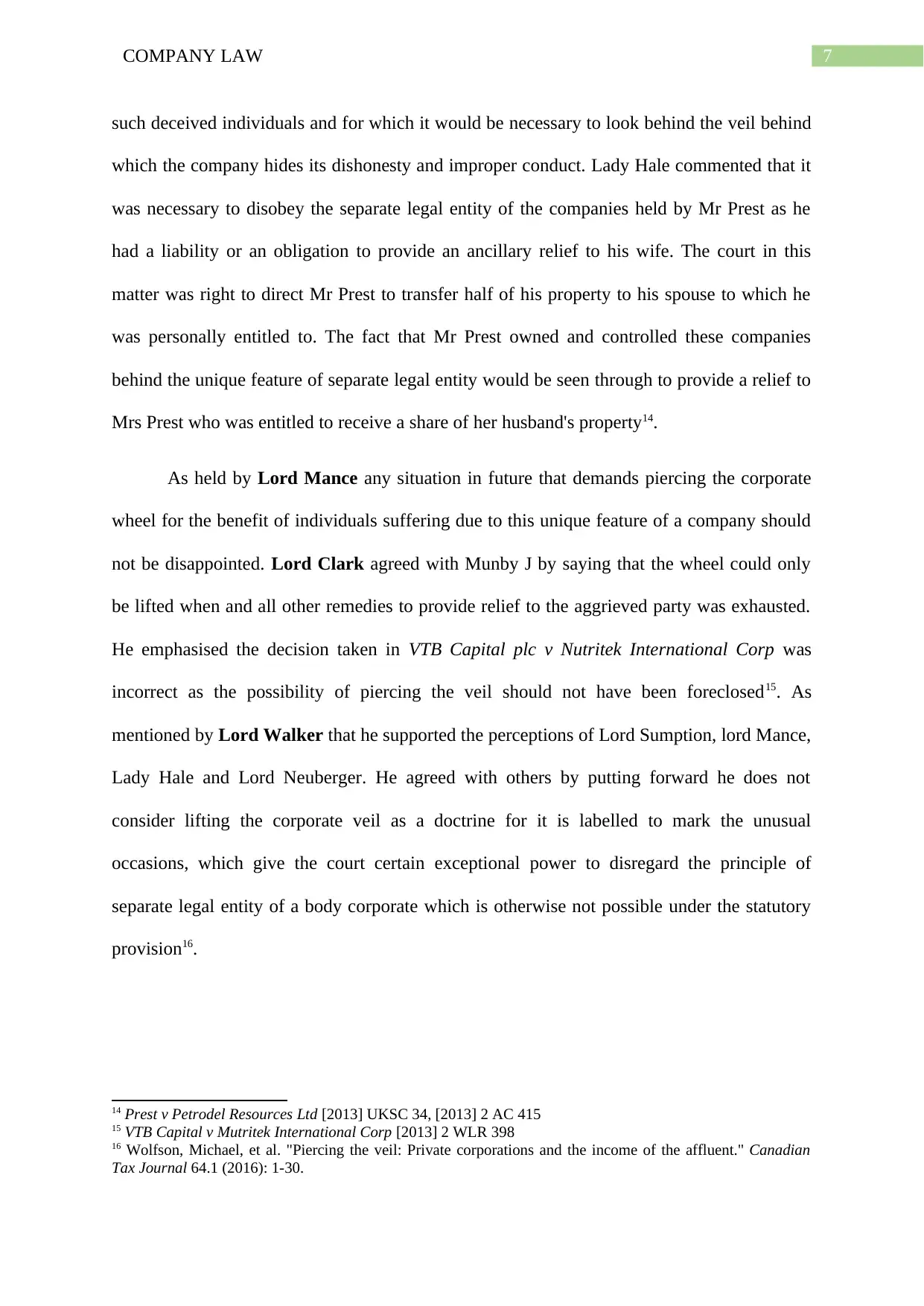
7COMPANY LAW
such deceived individuals and for which it would be necessary to look behind the veil behind
which the company hides its dishonesty and improper conduct. Lady Hale commented that it
was necessary to disobey the separate legal entity of the companies held by Mr Prest as he
had a liability or an obligation to provide an ancillary relief to his wife. The court in this
matter was right to direct Mr Prest to transfer half of his property to his spouse to which he
was personally entitled to. The fact that Mr Prest owned and controlled these companies
behind the unique feature of separate legal entity would be seen through to provide a relief to
Mrs Prest who was entitled to receive a share of her husband's property14.
As held by Lord Mance any situation in future that demands piercing the corporate
wheel for the benefit of individuals suffering due to this unique feature of a company should
not be disappointed. Lord Clark agreed with Munby J by saying that the wheel could only
be lifted when and all other remedies to provide relief to the aggrieved party was exhausted.
He emphasised the decision taken in VTB Capital plc v Nutritek International Corp was
incorrect as the possibility of piercing the veil should not have been foreclosed15. As
mentioned by Lord Walker that he supported the perceptions of Lord Sumption, lord Mance,
Lady Hale and Lord Neuberger. He agreed with others by putting forward he does not
consider lifting the corporate veil as a doctrine for it is labelled to mark the unusual
occasions, which give the court certain exceptional power to disregard the principle of
separate legal entity of a body corporate which is otherwise not possible under the statutory
provision16.
14 Prest v Petrodel Resources Ltd [2013] UKSC 34, [2013] 2 AC 415
15 VTB Capital v Mutritek International Corp [2013] 2 WLR 398
16 Wolfson, Michael, et al. "Piercing the veil: Private corporations and the income of the affluent." Canadian
Tax Journal 64.1 (2016): 1-30.
such deceived individuals and for which it would be necessary to look behind the veil behind
which the company hides its dishonesty and improper conduct. Lady Hale commented that it
was necessary to disobey the separate legal entity of the companies held by Mr Prest as he
had a liability or an obligation to provide an ancillary relief to his wife. The court in this
matter was right to direct Mr Prest to transfer half of his property to his spouse to which he
was personally entitled to. The fact that Mr Prest owned and controlled these companies
behind the unique feature of separate legal entity would be seen through to provide a relief to
Mrs Prest who was entitled to receive a share of her husband's property14.
As held by Lord Mance any situation in future that demands piercing the corporate
wheel for the benefit of individuals suffering due to this unique feature of a company should
not be disappointed. Lord Clark agreed with Munby J by saying that the wheel could only
be lifted when and all other remedies to provide relief to the aggrieved party was exhausted.
He emphasised the decision taken in VTB Capital plc v Nutritek International Corp was
incorrect as the possibility of piercing the veil should not have been foreclosed15. As
mentioned by Lord Walker that he supported the perceptions of Lord Sumption, lord Mance,
Lady Hale and Lord Neuberger. He agreed with others by putting forward he does not
consider lifting the corporate veil as a doctrine for it is labelled to mark the unusual
occasions, which give the court certain exceptional power to disregard the principle of
separate legal entity of a body corporate which is otherwise not possible under the statutory
provision16.
14 Prest v Petrodel Resources Ltd [2013] UKSC 34, [2013] 2 AC 415
15 VTB Capital v Mutritek International Corp [2013] 2 WLR 398
16 Wolfson, Michael, et al. "Piercing the veil: Private corporations and the income of the affluent." Canadian
Tax Journal 64.1 (2016): 1-30.
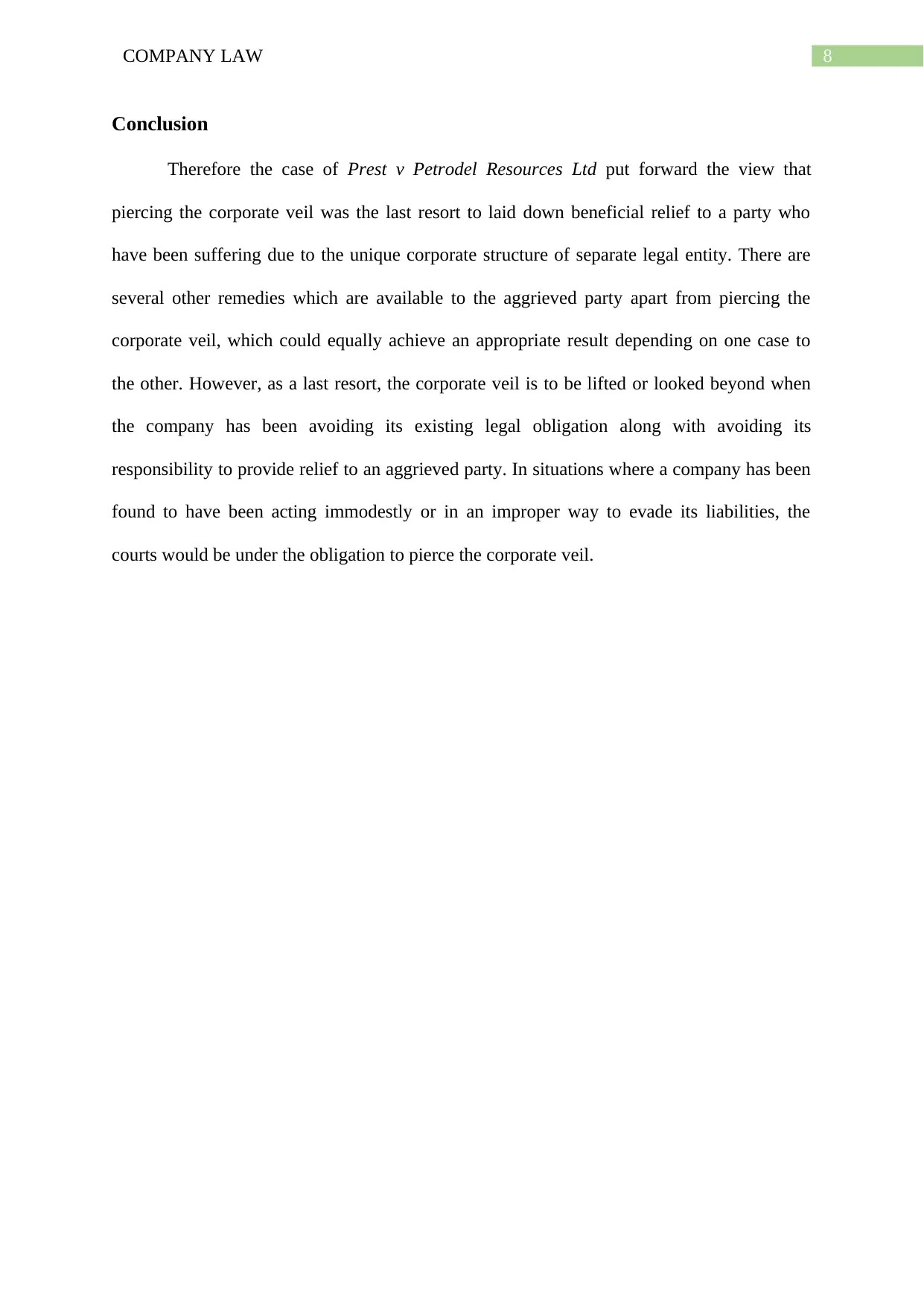
8COMPANY LAW
Conclusion
Therefore the case of Prest v Petrodel Resources Ltd put forward the view that
piercing the corporate veil was the last resort to laid down beneficial relief to a party who
have been suffering due to the unique corporate structure of separate legal entity. There are
several other remedies which are available to the aggrieved party apart from piercing the
corporate veil, which could equally achieve an appropriate result depending on one case to
the other. However, as a last resort, the corporate veil is to be lifted or looked beyond when
the company has been avoiding its existing legal obligation along with avoiding its
responsibility to provide relief to an aggrieved party. In situations where a company has been
found to have been acting immodestly or in an improper way to evade its liabilities, the
courts would be under the obligation to pierce the corporate veil.
Conclusion
Therefore the case of Prest v Petrodel Resources Ltd put forward the view that
piercing the corporate veil was the last resort to laid down beneficial relief to a party who
have been suffering due to the unique corporate structure of separate legal entity. There are
several other remedies which are available to the aggrieved party apart from piercing the
corporate veil, which could equally achieve an appropriate result depending on one case to
the other. However, as a last resort, the corporate veil is to be lifted or looked beyond when
the company has been avoiding its existing legal obligation along with avoiding its
responsibility to provide relief to an aggrieved party. In situations where a company has been
found to have been acting immodestly or in an improper way to evade its liabilities, the
courts would be under the obligation to pierce the corporate veil.
⊘ This is a preview!⊘
Do you want full access?
Subscribe today to unlock all pages.

Trusted by 1+ million students worldwide
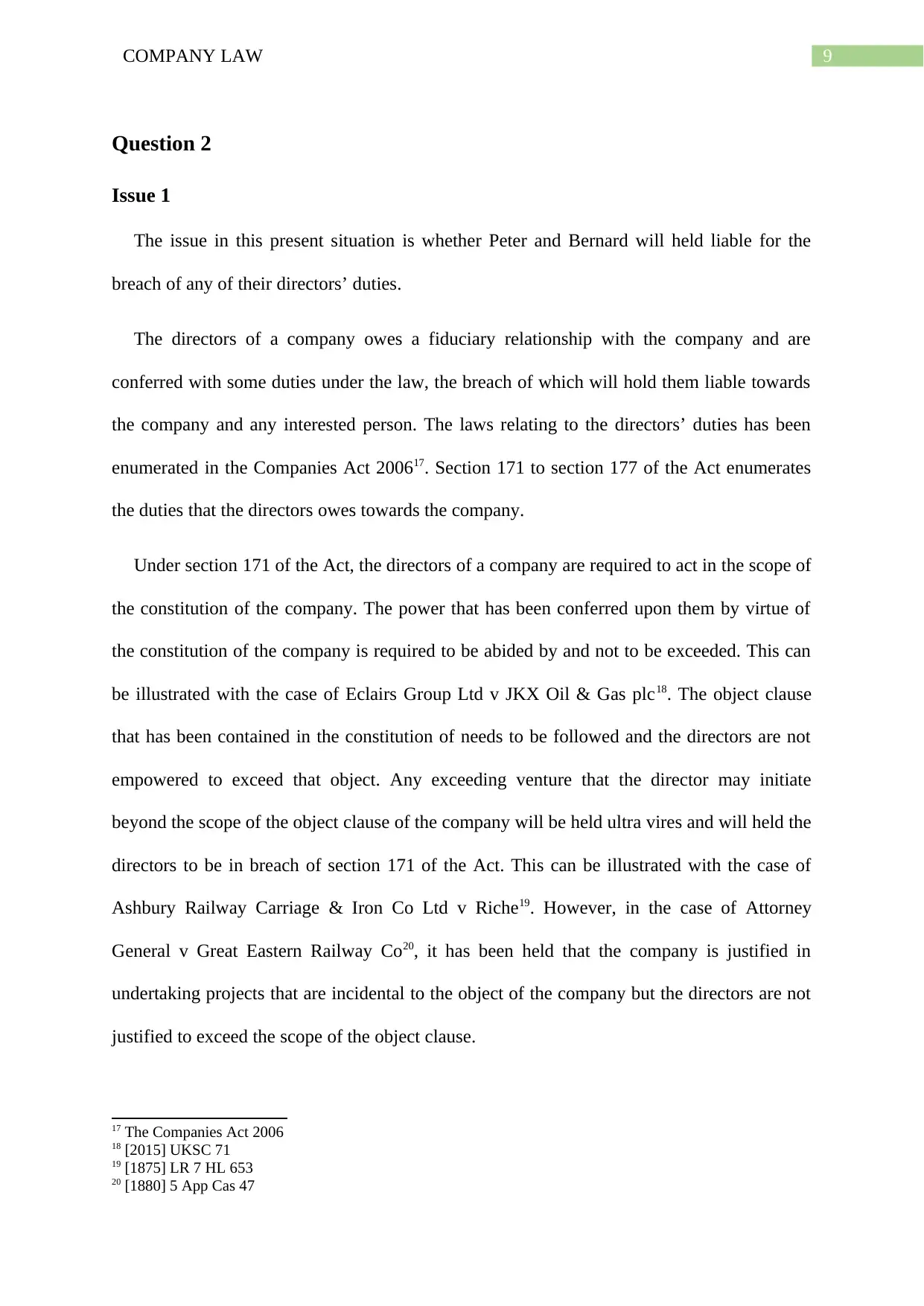
9COMPANY LAW
Question 2
Issue 1
The issue in this present situation is whether Peter and Bernard will held liable for the
breach of any of their directors’ duties.
The directors of a company owes a fiduciary relationship with the company and are
conferred with some duties under the law, the breach of which will hold them liable towards
the company and any interested person. The laws relating to the directors’ duties has been
enumerated in the Companies Act 200617. Section 171 to section 177 of the Act enumerates
the duties that the directors owes towards the company.
Under section 171 of the Act, the directors of a company are required to act in the scope of
the constitution of the company. The power that has been conferred upon them by virtue of
the constitution of the company is required to be abided by and not to be exceeded. This can
be illustrated with the case of Eclairs Group Ltd v JKX Oil & Gas plc18. The object clause
that has been contained in the constitution of needs to be followed and the directors are not
empowered to exceed that object. Any exceeding venture that the director may initiate
beyond the scope of the object clause of the company will be held ultra vires and will held the
directors to be in breach of section 171 of the Act. This can be illustrated with the case of
Ashbury Railway Carriage & Iron Co Ltd v Riche19. However, in the case of Attorney
General v Great Eastern Railway Co20, it has been held that the company is justified in
undertaking projects that are incidental to the object of the company but the directors are not
justified to exceed the scope of the object clause.
17 The Companies Act 2006
18 [2015] UKSC 71
19 [1875] LR 7 HL 653
20 [1880] 5 App Cas 47
Question 2
Issue 1
The issue in this present situation is whether Peter and Bernard will held liable for the
breach of any of their directors’ duties.
The directors of a company owes a fiduciary relationship with the company and are
conferred with some duties under the law, the breach of which will hold them liable towards
the company and any interested person. The laws relating to the directors’ duties has been
enumerated in the Companies Act 200617. Section 171 to section 177 of the Act enumerates
the duties that the directors owes towards the company.
Under section 171 of the Act, the directors of a company are required to act in the scope of
the constitution of the company. The power that has been conferred upon them by virtue of
the constitution of the company is required to be abided by and not to be exceeded. This can
be illustrated with the case of Eclairs Group Ltd v JKX Oil & Gas plc18. The object clause
that has been contained in the constitution of needs to be followed and the directors are not
empowered to exceed that object. Any exceeding venture that the director may initiate
beyond the scope of the object clause of the company will be held ultra vires and will held the
directors to be in breach of section 171 of the Act. This can be illustrated with the case of
Ashbury Railway Carriage & Iron Co Ltd v Riche19. However, in the case of Attorney
General v Great Eastern Railway Co20, it has been held that the company is justified in
undertaking projects that are incidental to the object of the company but the directors are not
justified to exceed the scope of the object clause.
17 The Companies Act 2006
18 [2015] UKSC 71
19 [1875] LR 7 HL 653
20 [1880] 5 App Cas 47
Paraphrase This Document
Need a fresh take? Get an instant paraphrase of this document with our AI Paraphraser
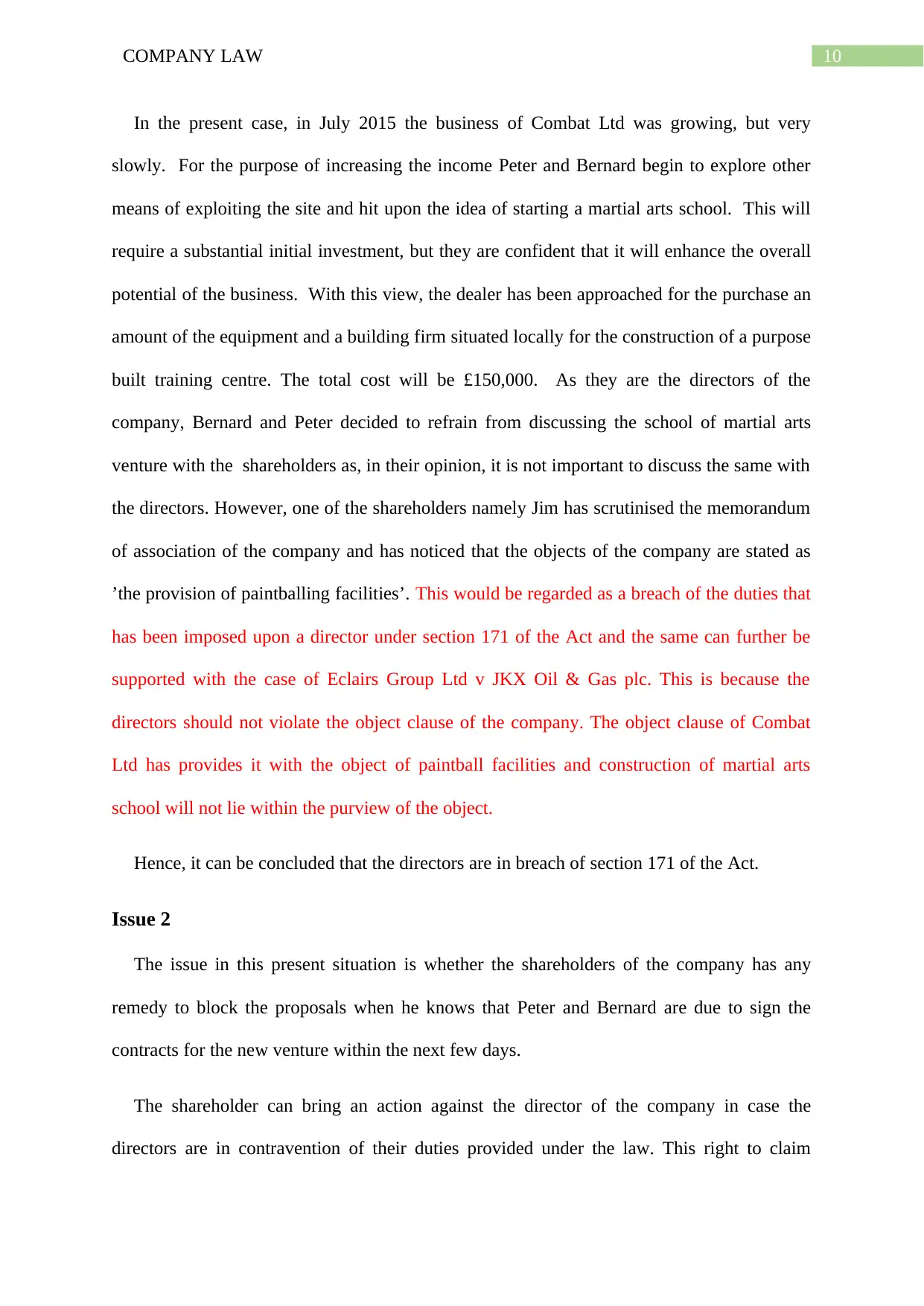
10COMPANY LAW
In the present case, in July 2015 the business of Combat Ltd was growing, but very
slowly. For the purpose of increasing the income Peter and Bernard begin to explore other
means of exploiting the site and hit upon the idea of starting a martial arts school. This will
require a substantial initial investment, but they are confident that it will enhance the overall
potential of the business. With this view, the dealer has been approached for the purchase an
amount of the equipment and a building firm situated locally for the construction of a purpose
built training centre. The total cost will be £150,000. As they are the directors of the
company, Bernard and Peter decided to refrain from discussing the school of martial arts
venture with the shareholders as, in their opinion, it is not important to discuss the same with
the directors. However, one of the shareholders namely Jim has scrutinised the memorandum
of association of the company and has noticed that the objects of the company are stated as
’the provision of paintballing facilities’. This would be regarded as a breach of the duties that
has been imposed upon a director under section 171 of the Act and the same can further be
supported with the case of Eclairs Group Ltd v JKX Oil & Gas plc. This is because the
directors should not violate the object clause of the company. The object clause of Combat
Ltd has provides it with the object of paintball facilities and construction of martial arts
school will not lie within the purview of the object.
Hence, it can be concluded that the directors are in breach of section 171 of the Act.
Issue 2
The issue in this present situation is whether the shareholders of the company has any
remedy to block the proposals when he knows that Peter and Bernard are due to sign the
contracts for the new venture within the next few days.
The shareholder can bring an action against the director of the company in case the
directors are in contravention of their duties provided under the law. This right to claim
In the present case, in July 2015 the business of Combat Ltd was growing, but very
slowly. For the purpose of increasing the income Peter and Bernard begin to explore other
means of exploiting the site and hit upon the idea of starting a martial arts school. This will
require a substantial initial investment, but they are confident that it will enhance the overall
potential of the business. With this view, the dealer has been approached for the purchase an
amount of the equipment and a building firm situated locally for the construction of a purpose
built training centre. The total cost will be £150,000. As they are the directors of the
company, Bernard and Peter decided to refrain from discussing the school of martial arts
venture with the shareholders as, in their opinion, it is not important to discuss the same with
the directors. However, one of the shareholders namely Jim has scrutinised the memorandum
of association of the company and has noticed that the objects of the company are stated as
’the provision of paintballing facilities’. This would be regarded as a breach of the duties that
has been imposed upon a director under section 171 of the Act and the same can further be
supported with the case of Eclairs Group Ltd v JKX Oil & Gas plc. This is because the
directors should not violate the object clause of the company. The object clause of Combat
Ltd has provides it with the object of paintball facilities and construction of martial arts
school will not lie within the purview of the object.
Hence, it can be concluded that the directors are in breach of section 171 of the Act.
Issue 2
The issue in this present situation is whether the shareholders of the company has any
remedy to block the proposals when he knows that Peter and Bernard are due to sign the
contracts for the new venture within the next few days.
The shareholder can bring an action against the director of the company in case the
directors are in contravention of their duties provided under the law. This right to claim
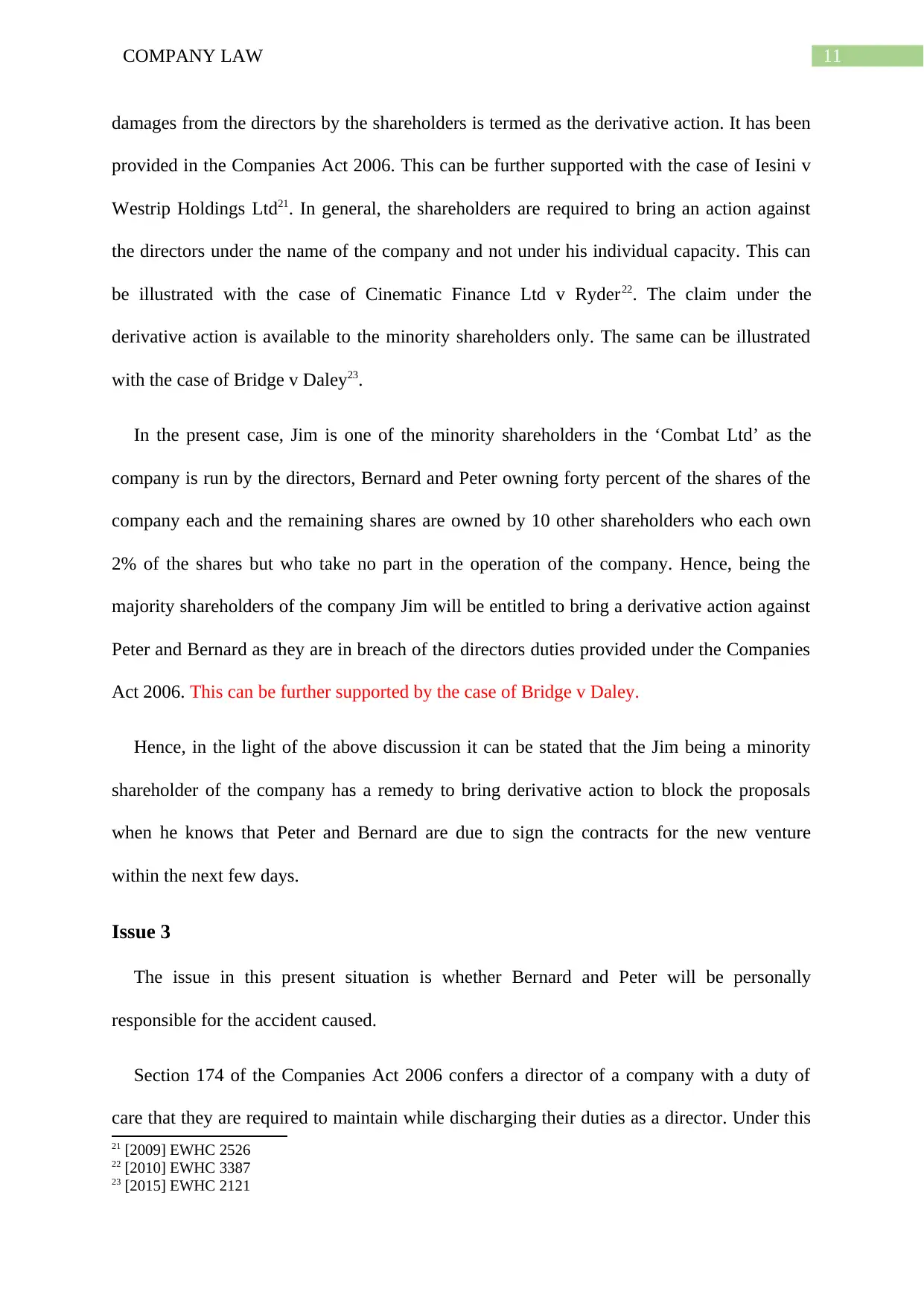
11COMPANY LAW
damages from the directors by the shareholders is termed as the derivative action. It has been
provided in the Companies Act 2006. This can be further supported with the case of Iesini v
Westrip Holdings Ltd21. In general, the shareholders are required to bring an action against
the directors under the name of the company and not under his individual capacity. This can
be illustrated with the case of Cinematic Finance Ltd v Ryder22. The claim under the
derivative action is available to the minority shareholders only. The same can be illustrated
with the case of Bridge v Daley23.
In the present case, Jim is one of the minority shareholders in the ‘Combat Ltd’ as the
company is run by the directors, Bernard and Peter owning forty percent of the shares of the
company each and the remaining shares are owned by 10 other shareholders who each own
2% of the shares but who take no part in the operation of the company. Hence, being the
majority shareholders of the company Jim will be entitled to bring a derivative action against
Peter and Bernard as they are in breach of the directors duties provided under the Companies
Act 2006. This can be further supported by the case of Bridge v Daley.
Hence, in the light of the above discussion it can be stated that the Jim being a minority
shareholder of the company has a remedy to bring derivative action to block the proposals
when he knows that Peter and Bernard are due to sign the contracts for the new venture
within the next few days.
Issue 3
The issue in this present situation is whether Bernard and Peter will be personally
responsible for the accident caused.
Section 174 of the Companies Act 2006 confers a director of a company with a duty of
care that they are required to maintain while discharging their duties as a director. Under this
21 [2009] EWHC 2526
22 [2010] EWHC 3387
23 [2015] EWHC 2121
damages from the directors by the shareholders is termed as the derivative action. It has been
provided in the Companies Act 2006. This can be further supported with the case of Iesini v
Westrip Holdings Ltd21. In general, the shareholders are required to bring an action against
the directors under the name of the company and not under his individual capacity. This can
be illustrated with the case of Cinematic Finance Ltd v Ryder22. The claim under the
derivative action is available to the minority shareholders only. The same can be illustrated
with the case of Bridge v Daley23.
In the present case, Jim is one of the minority shareholders in the ‘Combat Ltd’ as the
company is run by the directors, Bernard and Peter owning forty percent of the shares of the
company each and the remaining shares are owned by 10 other shareholders who each own
2% of the shares but who take no part in the operation of the company. Hence, being the
majority shareholders of the company Jim will be entitled to bring a derivative action against
Peter and Bernard as they are in breach of the directors duties provided under the Companies
Act 2006. This can be further supported by the case of Bridge v Daley.
Hence, in the light of the above discussion it can be stated that the Jim being a minority
shareholder of the company has a remedy to bring derivative action to block the proposals
when he knows that Peter and Bernard are due to sign the contracts for the new venture
within the next few days.
Issue 3
The issue in this present situation is whether Bernard and Peter will be personally
responsible for the accident caused.
Section 174 of the Companies Act 2006 confers a director of a company with a duty of
care that they are required to maintain while discharging their duties as a director. Under this
21 [2009] EWHC 2526
22 [2010] EWHC 3387
23 [2015] EWHC 2121
⊘ This is a preview!⊘
Do you want full access?
Subscribe today to unlock all pages.

Trusted by 1+ million students worldwide
1 out of 18
Related Documents
Your All-in-One AI-Powered Toolkit for Academic Success.
+13062052269
info@desklib.com
Available 24*7 on WhatsApp / Email
![[object Object]](/_next/static/media/star-bottom.7253800d.svg)
Unlock your academic potential
Copyright © 2020–2025 A2Z Services. All Rights Reserved. Developed and managed by ZUCOL.





